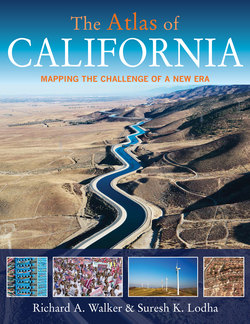Читать книгу The Atlas of California - Suresh K. Lodha - Страница 23
На сайте Литреса книга снята с продажи.
ОглавлениеPopulation
California is the most populous state in the United States and for decades was among the fastest growing, due to high immigration and birth rates.
Nearly one-eighth of people in the United States live in California; no other state is close. California has long boasted rapid population growth, drawing in large numbers of migrants from other countries and from elsewhere in the USA, because of its continuous economic expansion and demand for labor. The weakened economy slowed the increase in the 2000s, making it the decade of least growth since the Gold Rush and the first when more people were born in California than moved into it. Immigration was way down from its peak in the 1980s, and there was no net migration from other states. Even so, California’s population rose from 34 million to 37 million between 2000 and 2010, and should exceed 40 million by 2020. Currently, 27 percent of California’s people are foreign-born, compared to 13 percent for the United States as a whole. Hispanics/Latinos made up more than a third of California’s population in 2010 and will soon pass Euro-Americans/Whites, whose share has fallen from over 90 percent in 1960 to 40 percent today. Asians overtook African-Americans as the next largest category in the 1980s. Native Americans make up fewer than 1 percent of the state’s population. Mixed race, at 2.6 percent, is an undercounted but growing category. The age distribution is that of a mature economy, with a large number of baby boomers retiring in the next 20 years. But the age distribution of immigrants is younger than that of the American-born, and they have larger families, on average. This key group provides the bulk of the labor force today and will continue to do so in the near future. Although most people are concentrated in the coastal metropolitan areas of Los Angeles, the Bay Area, and San Diego, rapid growth is occurring in the Inland Empire of Riverside and San Bernardino counties in Southern California, and the Central Valley from Sacramento to Bakersfield in Northern California. The geographic distribution of people by ethnicity/race and national origin is also uneven: Whites dominate in the mountainous areas, while Hispanics/Latinos are disproportionate in the inland valleys. The coastal cities are the most mixed.
24
